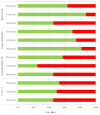Influence of the Single Coronary Vessel on Acute Outcomes of In-Stent CTO Recanalization
- PMID: 39076914
- PMCID: PMC11266836
- DOI: 10.31083/j.rcm2307249
Influence of the Single Coronary Vessel on Acute Outcomes of In-Stent CTO Recanalization
Abstract
Objective: Recanalization of in-stent chronic total occlusion (IS-CTO) is challenging and has resulted in inconsistent results. The aim of our study was to analyze the influence of the individual coronary vessels on the acute outcomes following IS-CTO PCI.
Methods: This was an observational retrospective study, including 66 patients undergoing recanalization of a CTO. The CTO interventions were performed bi-femoral using 7-French guiding catheters. A composite endpoint summarizing severe complications was evaluated, including emergency coronary artery bypass grafting surgery (CABG) and cardiac death.
Results: We subdivided our cohort into three groups (LAD group, LCX group, RCA group). The retrograde technique and the utilization of an extension catheter were used more frequently in patients with a RCA IS-CTO. There was no significant difference between the composite safety endpoints amongst the three groups. Technical success was independent of the involved vessel.
Conclusions: Success and complication rates are independent of the occluded vessel. This challenging and complex coronary intervention is feasible and can be carried out in complete safety.
Keywords: acute outcome; in-stent chronic total occlusion; percutaneous coronary intervention; single coronary artery.
Copyright: © 2022 The Author(s). Published by IMR Press.
Conflict of interest statement
The authors declare no conflict of interest.
Figures
References
-
- Azzalini L, Jolicoeur EM, Pighi M, Millán X, Picard F, Tadros V, et al. Epidemiology, Management Strategies, and Outcomes of Patients with Chronic Total Coronary Occlusion. The American Journal of Cardiology . 2016;118:1128–1135. - PubMed
-
- Fefer P, Knudtson ML, Cheema AN, Galbraith PD, Osherov AB, Yalonetsky S, et al. Current Perspectives on Coronary Chronic Total Occlusions. The Canadian Multicenter Chronic Total Occlusions Registry. Journal of the American College of Cardiology . 2012;59:991–997. - PubMed
-
- Tomasello SD, Boukhris M, Giubilato S, Marzà F, Garbo R, Contegiacomo G, et al. Management strategies in patients affected by chronic total occlusions: results from the Italian Registry of Chronic Total Occlusions. European Heart Journal . 2015;36:3189–3198. - PubMed
-
- Galassi AR, Tomasello SD, Reifart N, Werner GS, Sianos G, Bonnier H, et al. In-hospital outcomes of percutaneous coronary intervention in patients with chronic total occlusion: insights from the ERCTO (European Registry of Chronic Total Occlusion) registry. EuroIntervention . 2011;7:472–477. - PubMed
LinkOut - more resources
Full Text Sources
Miscellaneous


